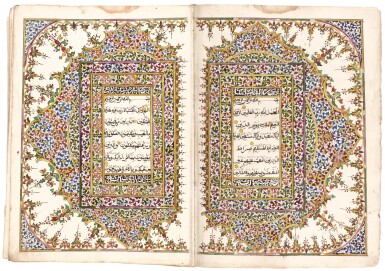Arts of the Islamic World & India including Fine Rugs & Carpets
Arts of the Islamic World & India including Fine Rugs & Carpets

A LARGE ILLUMINATED QUR'AN, INDONESIA, DATED 1315 AH/1897-98 AD
Auction Closed
June 10, 06:00 PM GMT
Estimate
3,000 - 5,000 GBP
Lot Details
Description
A LARGE ILLUMINATED QUR'AN, INDONESIA, DATED 1315 AH/1897-98 AD
Arabic manuscript on watermarked paper, 321 leaves, 15 lines to the page, written in naskh in black ink, ruled in black, yellow and red, verses separated by yellow roundels, surah headings in red rounded cursive, polychrome verse markers in the margins, f.1b with an illuminated leaf bearing the date of completion of the manuscript, f.3b and 5a with a double-page spread of illumination consisting of 7 lines of naskh surrounded by an intricate frame of interlacing palmettes, similar bifolium at the middle and end of the Qur’an, followed by 8 leaves with prayers starting with a bifolium with double polychrome headings, lacking binding
33 by 23.5cm.
Please note: Condition 9 of the Conditions of Business for Buyers for this sale is not applicable to this lot.
The vast majority of surviving manuscripts produced in South East Asia are dated from the seventeenth century onwards, the most numerous attributed to the nineteenth century, such as the present example. Although lacking a colophon, f.1b bears the hijri date 1315 (1897 AD) and the name of al-Shaykh al-Imam al-Hafiz Muhammad as its owner.
The manuscript lacks a binding, revealing its internal structure. The beginning, middle and end of the Qur’an are marked by a double-spread decorated with blue, red, yellow and black, separated by a plain sheet which was inserted to avoid any corrosion or trespassing of the illuminating colours. One of the most interesting aspects of this Qur’an is its paper, which bears the Italian watermark of Andrea Galvani. The Galvani family is recorded as making paper since the first quarter of the eighteenth century. Based in the Veneto, in the north of Italy, they owned several mills and also a ceramic factory, exporting their products all over Africa and Asia. Several Arabic manuscripts attributed to the Sub-Saharan region were written on Galvani’s watermarked paper and since the 1730s their paper was largely exported to the Near East, as shown by “reports of Arab and Turks frequently coming to Pordenone to demand [this] product” (Biddle 2017, p.45). Different watermarks can be linked to the Galvani family and attributed to different periods of their business. The current watermark, which reads ‘Andrea Galvani Pordenone’ and ‘AG’, depicting the moon in a simple crest, is dated to the late nineteenth, early twentieth century (for an image of a plain sheet with the same watermarks see sheet no.37 from the James McBey Collection of watermarked paper, circa 1917, published in Biddle 2017, p.55).
For an extensive discussion on Arabic manuscripts from South East Asia, see Annabel Gallop’s contribution: 'Islamic manuscript art of Southeast Asia', Crescent moon: Islamic art & civilisation in Southeast Asia, James Bennett (ed.), Art Gallery of South Australia, Adelaide, 2005, pp.156-183. See also Annabel Gallop's article 'Fake or fancies? Some ‘problematic’ Islamic manuscripts from South East Asia' in Manuscript Cultures no.10, Hamburg, 2017. For further information on the Galvani’s watermark, see Michaelle Biddle’s article, 'New Strategies in using watermarks to date sub-Saharan Islamic manuscripts', published by De Gruyter 2017, available online: https://www.degruyter.com/downloadpdf/books/9783110541441/9783110541441-002/9783110541441-002.pdf
